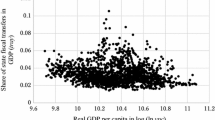Summary and conclusions
The motives of the state in projecting a more than minimal presence in the economy may be conceived of as benevolent or malevolent. Whatever the characterization of the motivation, increases in the size of the government share of the economy adversely affect economic growth and the allocation of resources. Nations with relatively large government shares in 1960 on the whole grew more slowly than nations with relatively small state sectors. Interperiod increases in the size of government were associated with lower growth rates over the period. The size of the government share coefficients in the regressions were of sufficiently large magnitude to conclude that the rise in the size of the government has had a substantial depressing effect on economic growth. These results are consistent with those reported by Landau (1983) and Marlow (1986). Landau did not adjust economic growth for the growth in factor endowment. Consequently, his results overstate the adverse effect of government size.
Government allocation of resources is thought to be less efficient than private allocation. For the first time in the literature, this hypothesis was tested directly by comparing efficiency measures with the measures of the size of the government sector. It was found that the size of the government share in the economy was negatively correlated with economic efficiency and with the inter-period change in economic efficiency. Nations with relatively large state sectors produced less output per head with the same input ratio than nations with relatively small government sectors.
Similar content being viewed by others
References
Aigner, D.J. and Chu, S.F. (1968). Estimating the industry production function. A.E.R. 58 (September): 826–839.
Aigner, D.J., Lovell, C.A. and Schmidt, P. (1977). Formulation and estimation of stochastic production models. Journal of Econometrics (January): 21–37.
Brennan, G. and Buchanan, J.M. (1980). The power to tax: Analytical foundations of a fiscal constitution. Cambridge: Cambridge University Press.
Buchanan, J.M. (1960). La scienza della finanze: The Italian tradition in fiscal theory. In J.M. Buchanan (Ed.), Fiscal theory and political economy, 24–74. Chapel Hill: University of North Carolina Press.
Buchanan, J.M. and Tullock, G. (1962). The calculus of consent. Ann Arbor: The University of Michigan Press.
Buchanan, J.M. (1975). The limits of liberty. Chicago: The University of Chicago Press.
Buchanan, J.M. (1980). Rent seeking and profit seeking. In J.M. Buchanan, G. Tullock and R.D. Tollison (Eds.), Toward a theory of the rent-seeking society, 3–15. College Station: Texas A&M University Press.
Caves, D.W., Christensen, L.R. and Diewert, W.E. (1982). Multilateral comparisons of output, input, and productivity using superlative index numbers. The Economic Journal 92 (March): 73–86.
Dempster, A.P., Laird, N.M. and Rubin, D.G. (1977). Maximum likelihood from incomplete data via the EM algorithm. Journal of the Royal Statistical Society, Series B 39: 1–38.
Downs, A. (1957). An economic theory of democracy. New York: Harper and Row.
Green, W.H. (1980). Maximum likelihood estimation of econometric frontier functions. Journal of Econometrics 13: 27–56.
Green, W.H. (1980). The estimation of a flexible frontier production model. Journal of Econometrics 13: 101–115.
Harberger, A.C. (1978). Perspectives on capital and technology in less-developed countries. In M.J. Artis and A.R. Nobay (Eds.), Contemporary Economic Analysis. London: Croom-Helm.
Huang, C.J. (1984). Estimation of stochastic frontier production function and technical inefficiency via the EM algorithm. Southern Economic Journal 50 (3): 847–856.
Krueger, A.O. (1974). The political economy of the rent-seeking society. American Economic Review 64 (June): 291–303.
Landau, D. (1983). Government expenditure and economic growth: A cross-country study. Southern Economic Journal 49 (January): 783–792.
Landau, D. Government and economic growth in the less-developed countries. Mimeo.
Marlow, M.L. (1986). Private sector shrinkage and the growth of industrialized economies. Public Choice 49: 143–154.
Musgrave, R.A. (1959). The theory of public finance. New York: McGraw Hill.
Nelson, M.A. (1985). Searching for Leviathan: Comment and extension. American Economic Review 75 (September): 198–204.
Niskanen, W.A., Jr. (1971). Bureaucracy and representative government. Chicago: Aldens and Atherton.
Oates, W. (1985). Searching for Leviathan. American Economic Review 75 (September): 748–757.
Olsen, M. (1965). The logic of collective action. Cambridge: Harvard University Press.
Peltzman, S. (1980). The growth of government. Journal of Law and Economics 23 (2) (October): 209–287.
Ram, R. (1986). Government size and economic growth: A new framework and some evidence from cross-section and time series data. American Economic Review 76 (March): 191–203.
Scully, G.W. (1988). The institutional framework and economic development. Journal of Political Economy 96 (June): 652–662.
Short, R.P. (1984). The role of public enterprises: An international statistical comparison. In R. Floyd, C. Gray and R.P. Short (Eds.), Public enterprise in mixed economies: Some international aspects, 110–194. Washington: International Monetary Fund, 99.
Stigler, G.J. (1970). Director's law of public income redistribution. Journal of Law and Economics 13 (April): 1–10.
Summers, R. and Heston, A. (1984). Improved international comparisons of real product and its composition: 1950–1980. Review of Income and Wealth (June): 207–262.
Tollison, R.D. (1982). Rent-seeking: A survey. Kyklos 35: 575–602.
Tullock, G. (1965). The politics of bureaucracy. Washington: Public Affairs Press.
Tullock, G. (1967). The welfare costs of tariffs, monopolies and theft. Western Economic Journal 5 (June): 224–232.
Tullock, G. (1983). Economics of income redistribution. Boston: Kluwer-Nijhoff.
Tullock, G. (1986). The economics of wealth and poverty. New York: New York University Press.
United Nations. Yearbook of national accounts statistics. New York: United Nations, various years.
Author information
Authors and Affiliations
Additional information
I thank K. Hayes, D. Slottje, and the editor for comments on an earlier draft.
Rights and permissions
About this article
Cite this article
Scully, G.W. The size of the state, economic growth and the efficient utilization of national resources. Public Choice 63, 149–164 (1989). https://doi.org/10.1007/BF00153397
Issue Date:
DOI: https://doi.org/10.1007/BF00153397




